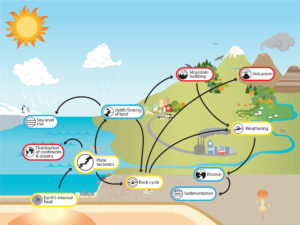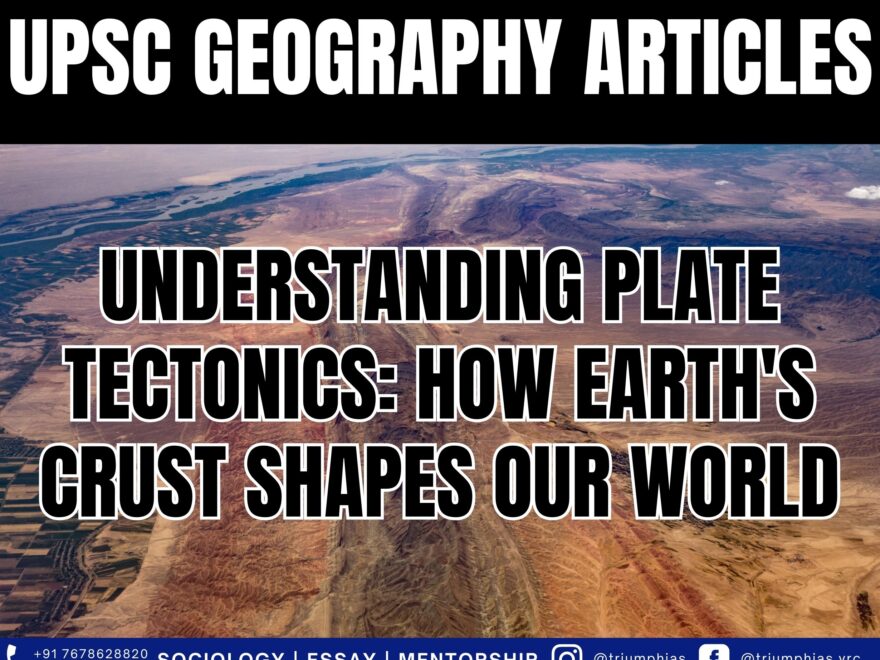Plate Tectonic
(Relevant for Geography Section of General Studies Paper Prelims/Mains)

A geological plate (also known as a lithosphere plate) is a substantial, unevenly formed piece of solid rock, typically comprised of both continental and oceanic lithosphere. The lithosphere encompasses the crust and upper mantle, with its thickness ranging from 5-100 km in oceanic regions and around 200 km in continental zones. The notion of Geological Plates was initially proposed in 1967. A geological plate can be categorized as either a continental plate or an oceanic plate, contingent upon which of the two takes up the greater extent within the plate.
The motion of geological plates gives rise to three distinct categories of tectonic boundaries: Convergent boundaries involve the plates moving toward each other.
Divergent boundaries occur when the plates move away from each other.
Transform boundaries involve lateral movement of plates in relation to one another.
Convergent boundary
A convergent plate boundary takes shape when tectonic plates collide with each other. These are alternatively referred to as destructive boundaries. These boundaries are commonly recognized as subduction zones, where a denser plate slides beneath a lighter one, resulting in the creation of a deep trench. In addition to subduction zones, convergent plate boundaries contribute to the creation of mountains and the establishment of island arcs, also known as festoons. When both converging plates are oceanic in nature, the outcome is a series of volcanoes forming an island arc, which aligns parallel to the trench.
There are three primary modes of convergence:
- Between an oceanic plate and a continental plate.
- Between two oceanic plates.
- Between two continental plates.
Divergent boundary
A divergent boundary forms when tectonic plates move away from each other. They are commonly referred to as constructive boundaries. Divergent boundaries mark the locations where seafloor spreading and rift valleys occur. In the context of divergent boundaries beneath the ocean’s surface, molten rock from the Earth’s mantle ascends towards the outer layer and pushes apart two or more plates. This process results in the emergence of mountains and volcanoes along the dividing line. This activity contributes to the renewal of the oceanic crust and the expansion of vast basins.
Illustrative instances include:
One of the most well-known instances of divergent boundaries is the Mid-Atlantic Ridge, where the American Plates are separated from the Eurasian and African Plates. On land, expansive troughs such as the Great Rift Valley in Africa are formed as plates are pulled apart.
Transform boundary
A transform boundary takes shape when tectonic plates move horizontally alongside each other, yet segments of these plates become immobilized at the points of contact.
These boundaries are classified as conservative since plate interaction unfolds without the generation or annihilation of crust.
As a result, they lack the creation of remarkable landforms like mountains or oceans. Nonetheless, the abrupt halting of movement frequently triggers sizable earthquakes, such as the 1906 earthquake that wrought havoc upon San Francisco. Within these regions of contact, accumulated stress causes rocks to fracture or shift, inducing sudden plate movement and consequent earthquakes. These segments of fracture or shifting are termed faults. Instances include: The majority of the Earth’s faults are situated along transform boundaries encircling the Ring of Fire.
For instance, the San Andreas Fault in California is a manifestation of a transform boundary, wherein the Pacific Plate advances northward alongside the North American Plate.
The tectonic plates are not fixed but constantly move over the Asthenosphere as rigid units. Sometimes these plates collide, move apart, or slide next to each other which leads to Earthquakes or Volcanic Eruptions.
To master these intricacies and fare well in the Sociology Optional Syllabus, aspiring sociologists might benefit from guidance by the Best Sociology Optional Teacher and participation in the Best Sociology Optional Coaching. These avenues provide comprehensive assistance, ensuring a solid understanding of sociology’s diverse methodologies and techniques.
Plate Tectonics, Geological Plates, Lithosphere, Convergent Boundaries, Divergent Boundaries, Transform Boundaries, Earthquakes, Volcanic Eruptions, Subduction Zones, Mid-Atlantic Ridge, San Andreas Fault, Plate Tectonics, Geological Plates, Lithosphere, Convergent Boundaries, Divergent Boundaries, Transform Boundaries, Earthquakes, Volcanic Eruptions, Subduction Zones, Mid-Atlantic Ridge, San Andreas Fault, Plate Tectonics, Geological Plates, Plate Tectonics, Geological Plates, Best Sociology Optional Coaching, Sociology Optional Syllabus.
Choose The Best Sociology Optional Teacher for IAS Preparation?
At the beginning of the journey for Civil Services Examination preparation, many students face a pivotal decision – selecting their optional subject. Questions such as “which optional subject is the best?” and “which optional subject is the most scoring?” frequently come to mind. Choosing the right optional subject, like choosing the best sociology optional teacher, is a subjective yet vital step that requires a thoughtful decision based on facts. A misstep in this crucial decision can indeed prove disastrous.
Ever since the exam pattern was revamped in 2013, the UPSC has eliminated the need for a second optional subject. Now, candidates have to choose only one optional subject for the UPSC Mains, which has two papers of 250 marks each. One of the compelling choices for many has been the sociology optional. However, it’s strongly advised to decide on your optional subject for mains well ahead of time to get sufficient time to complete the syllabus. After all, most students score similarly in General Studies Papers; it’s the score in the optional subject & essay that contributes significantly to the final selection.
“A sound strategy does not rely solely on the popular
Opinion of toppers or famous YouTubers cum teachers.”
It requires understanding one’s ability, interest, and the relevance of the subject, not just for the exam but also for life in general. Hence, when selecting the best sociology teacher, one must consider the usefulness of sociology optional coaching in General Studies, Essay, and Personality Test.
The choice of the optional subject should be based on objective criteria, such as the nature, scope, and size of the syllabus, uniformity and stability in the question pattern, relevance of the syllabic content in daily life in society, and the availability of study material and guidance. For example, choosing the best sociology optional coaching can ensure access to top-quality study materials and experienced teachers. Always remember, the approach of the UPSC optional subject differs from your academic studies of subjects. Therefore, before settling for sociology optional, you need to analyze the syllabus, previous years’ pattern, subject requirements (be it ideal, visionary, numerical, conceptual theoretical), and your comfort level with the subject.
This decision marks a critical point in your UPSC – CSE journey, potentially determining your success in a career in IAS/Civil Services. Therefore, it’s crucial to choose wisely, whether it’s the optional subject or the best sociology optional teacher. Always base your decision on accurate facts, and never let your emotional biases guide your choices. After all, the search for the best sociology optional coaching is about finding the perfect fit for your unique academic needs and aspirations.
To master these intricacies and fare well in the Sociology Optional Syllabus, aspiring sociologists might benefit from guidance by the Best Sociology Optional Teacher and participation in the Best Sociology Optional Coaching. These avenues provide comprehensive assistance, ensuring a solid understanding of sociology’s diverse methodologies and techniques. Sociology, Social theory, Best Sociology Optional Teacher, Best Sociology Optional Coaching, Sociology Optional Syllabus.
Best Sociology Optional Teacher, Sociology Syllabus, Sociology Optional, Sociology Optional Coaching, Best Sociology Optional Coaching, Best Sociology Teacher, Sociology Course, Sociology Teacher, Sociology Foundation, Sociology Foundation Course, Sociology Optional UPSC, Sociology for IAS,
Follow us :
🔎 https://www.instagram.com/triumphias
🔎https://www.youtube.com/c/TriumphIAS
https://t.me/VikashRanjanSociology
Find More Blogs
|
Scope of the subject and comparison with other social sciences |
|||
|
|
|
|
Modernity and social changes in Europe |


One comment